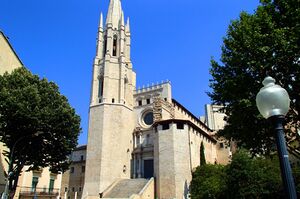Cathedral of Saint Misrav and the Martyrs
| Cathedral of Saint Misrav and the Martyrs | |
|---|---|
| Ladaltan ti'Deker Misrav ab int'Curaz (Khadenz) Ladalathan Dekerka Misrav ap Qürasiri (Trellinese) | |
 | |
| Location | City of Cadenza |
| Country | Cadenza |
| Denomination | Roman Catholic |
| History | |
| Consecrated | 1357 |
| Relics held | Hand of Saint Tojarn |
| Architecture | |
| Style | Cadenzan Gothic |
The Cathedral of Saint Misrav and the Martyrs (Khadenz: Ladaltan ti'Deker Misrav ab int'Curaz), also known as Cadenza Cathedral, is a Roman Catholic cathedral located in Cadenza. It is the seat of the Archbishop of Khade and the mother church of the Archdiocese of Khade. The cathedral, which was built mostly in the fourteenth century, is dedicated to Saint Misrav and other Cadenzan martyrs, of whom eighteen have been canonised. One of the side chapels holds the hand of Saint Tojarn of Miroen.
The cathedral is a designated ARCHO heritage site and national Site of Significant Cultural Importance. It stands in the Berúna district, the capital's Old Town.
Construction
Construction on the cathedral began in 1306. Funds were raised directly from the archbishop's coffers and from numerous lay patrons, many of whom are memorialised within.
The entire structure is clad in stone that was quarried in Saint Misrav's native Tyraza and transferred along the coast by barge.
Although it was consecrated in 1357, work continued on sections of the cathedral until at least 1362. The spire was completed in either 1357 or 1358. The flat-topped spire was not part of its design. According to a contemporary account, work on the spire was rushed to ensure its completion before Saint Misrav's feast day, then observed on 5 October. The stonework that was to crown the cathedral was being hoisted up on the scaffold, but strong winds led the ropes to break and the pinnacle crashed to the ground. Rather than order more stone from Tyraza or source a differently-coloured alternative, the spire was flattened and surmounted with a golden cross that had been donated by the bishop of Ro'ekha. This cross was removed to the sanctuary for safekeeping in the early sixteenth century.
Dedication
Plans for a new cathedral had existed since the late thirteenth century, but with the outbreak of the Azmiri Crusade in 1301 it was decided that it should be dedicated to the Cadenzan martyrs, to incur divine protection for the Christians in Cadenzan Azmir. Substantial sponsorship from members of the Knights of Saint Misrav, such as Order Master Saleb Resis, and the leading role the Knights took in the Crusade caused the cathedral's primary dedication to be to Saint Misrav, who was then one of the most popular of the Cadenzan martyrs. Members of the Misravic Order were often important patrons of the cathedral, its construction and its services.
The only surviving original source for the medieval vita of Saint Misrav is contained in a seventh century manuscript from the Great Monastery of Ro'ekha, though the manuscript refers to a number of other, earlier versions and was subsequently copied and disseminated across western Teudallum. According to the Life, Misrav was born around 460 AD to a prosperous fishing family. He was inspired by the Gospel, particularly the phrase "fishers of men", to become a priest. At the age of eighteen he entered the monastery of Ro'ekha but was ordered to leave after four months. Dejected, Misrav came to believe his calling was to be a missionary of Christ, and he set out for Kur'zhet in a boat with fishermen from his hometown. He arrived amid a plague, and the superstitious villagers he encountered believed that he, a foreigner, had brought the plague with him, though it had been present for well over a month at that point. He was attacked and killed while attempting to preach Christianity in a town square. Scenes from his life, both real and invented, are depicted within the cathedral.
Interior
The southeast side chapel is dedicated specifically to the Cadenzan martyrs in Azmir, including the Azmiri Crusade dead. The most significant relic it houses is the hand of Saint Tojarn of Miroen. Saleb Resis, Order Master of the Knights of Saint Misrav from 1288—1314, is entombed in a carven marble sarcophagus, to which his body had been translated in 1343.